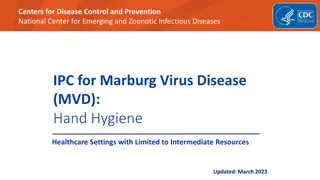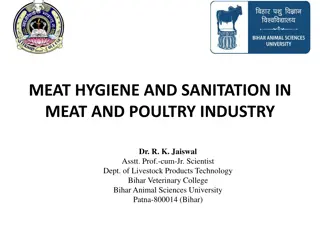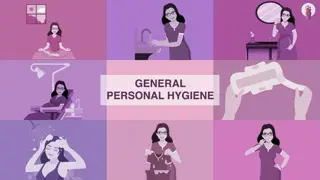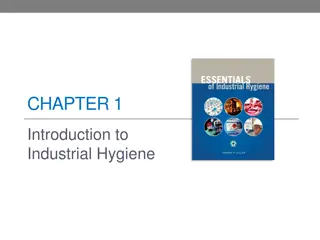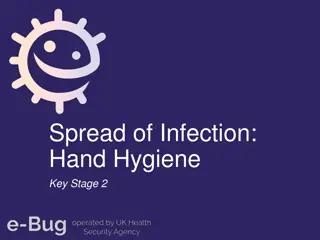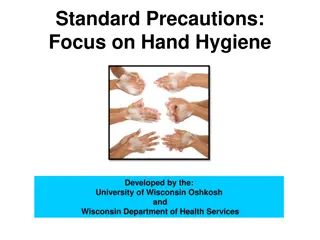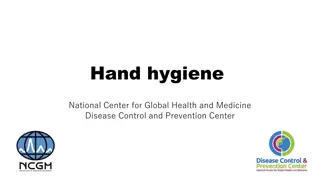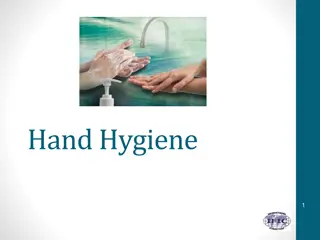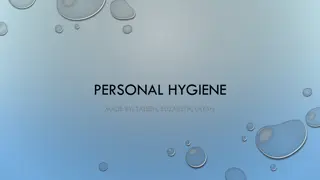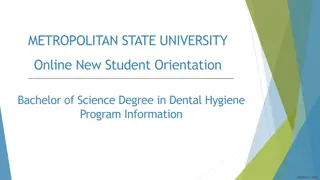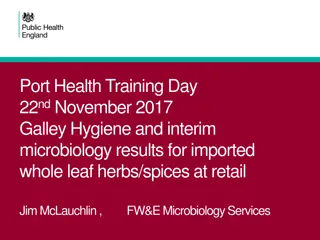The Significance of Environmental Hygiene in Public Health
Environment and environmental hygiene play pivotal roles in public health by encompassing factors that influence human health and well-being. Environmental hygiene focuses on controlling adverse conditions in the physical environment to maintain and enhance health. It aims at preventing and managing biological, chemical, physical, sociological, and psychological hazards that can impact individuals and society. Understanding environmental hazards and modes of transmission are crucial in implementing effective preventive measures. Chemical exposure, both natural and man-made, can lead to toxicity and health implications. Awareness of these aspects is essential for promoting a sustainable and healthful living environment for present and future generations.
Download Presentation

Please find below an Image/Link to download the presentation.
The content on the website is provided AS IS for your information and personal use only. It may not be sold, licensed, or shared on other websites without obtaining consent from the author. Download presentation by click this link. If you encounter any issues during the download, it is possible that the publisher has removed the file from their server.
E N D
Presentation Transcript
SCOPE AND IMPORTANCE OF ENVIRONMENT & ENVIRONMENTAL HYGIENE 8/9/2024 1
Environment: It is the sum total of all external conditions and influences affecting the life and development of any living being. Hygiene: is the science of health encompassing everything that contributes to a healthful living. Environmental hygiene: The branch of public health that is concerned with the control of all those factors in man s surrounding or physical environment which may have deleterious effect on human health and well being. It should not only aim at preserving the health but also improving it. or factors in the environment. All those aspects of public health that are determined by physical, chemical, biological, social and psychological the environment that can potentially affect the health of present and future generations. It also includes theories and practices of assessing, correcting, controlling and preventing the factors present in 8/9/2024 2
OBJECTIVES Prevention and control of biological hazards. Prevention and control of chemical hazards. Prevention and control of physical hazards. Prevention and control of sociological and psychological hazards. 8/9/2024 3
Environmental Hazards Chemical Physical Biological Vibrations Radiation Humidity Animal Insect Microbiological Poisons/Toxins Allergens Irritants Psychological Sociological Stress Boredom Anxiety Discomfort Depression Overcrowding Isolation 8/9/2024 4
Biological Host Source Mode of transmission Route of entry Receptor Man or Animal Direct contact Aerosol Water Arthropods Skin lesions Nose/Mouth Food/Water Man or Animal 8/9/2024 5
Chemical Toxicity Poisons/Toxins Allergens Irritants Susceptibility Duration of exposure Concentration Form solid liquid gas Synergism may be seen, too 8/9/2024 6
Exposure may be Natural Methemoglobinemia blue babies Water Mottled tooth enamel irritation/ disease / death Gas Ensilage disease (nitrogen dioxide) Hydrogen sulphide 8/9/2024 7
Accumulation over time in food materials Atmospheric chemical may undergo reaction Polluted oxidizing atmosphere Hydrocarbon Oxides of nitrogen Polluted reducing atmosphere Particulate matter Oxides of sulfur 8/9/2024 8
Physical Death Temperature & Humidity: Disease 1-320C range of critical temperature Disability 24-310C thermoneutrality zone Affects Factors: metabolic rate Dust oxygen consumption Humidity respiration rate Equipment heart beat Radiation blood pressure 8/9/2024 9
Sociological & Psychological Noise Overcrowding Lack of privacy Lack of open space Traffic Lack of opportunity Stress form work 8/9/2024 10
Man-Environment Relationship Life support Man s activities Residues & wastes Air Home Solids Water Work Liquids Food Recreation Gases Shelter Transportation Environmental Hazards 8/9/2024 11
Environmental conditions - Necessary Air Water Food Shelter - Affect Function Performance Comfort 8/9/2024 12
Spread Dispersal Pollutants Infection Air 78% - Nitrogen 21% - Oxygen <16% - Anoxia develops <6% - Life cannot be sustained ZERO oxygen immediate loss of consciousness 8/9/2024 13
Survival for days Water Civilization cannot prosper Sufficient quantity Good quality Food Sufficient quantity Acceptable quality Shelter Location dependent 8/9/2024 14
Residues and wastes Human Residential Agricultural No useful purpose Commercial Marginal utility Industrial Uneconomical recovery 8/9/2024 15
SCOPE OF ENVIRONMENTAL HYGIENE Water supply with special reference to the provision of adequate quantity of safe water to user. Waste-water treatment and water pollution control including collection, treatment and disposal of domestic sewage and other water-borne wastes besides control of surface and ground water quality. Solid-waste management including sanitary handling and disposal. 8/9/2024 16
Vector control. Prevention and control of soil pollution by human excreta and substances detrimental to human, animal and plant life. Food hygiene including milk hygiene. Air pollution control. Radiation pollution control. Noise pollution control. 8/9/2024 17
Occupational health particularly the control of physical, chemical and biological hazards. Housing and its immediate environment with particular reference to the public health aspects of residential, public and institutional buildings. Urban and regional planning. Environmental health aspects of air, sea or land transport. Accident prevention. 8/9/2024 18
Public recreation and tourism particularly environmental health aspect of public beaches, swimming pools, camping sites etc. Sanitation measures during epidemics, emergencies, disaster and population migration. Wild life and forest conservation. Preventive measures to ensure freedom from health risk of the general environment. 8/9/2024 19
Reference books/sources 1. Text book of Elements of Veterinary Public Health By A.T. Sherikar, V.N. Bachhil and D.C. Thapliyal, ICAR, New Delhi 2. Park s Textbook of Preventive and Social Medicine, 24th Edition By: K. Park, Banarsidas Bhanot Publishers. 8/9/2024 20



